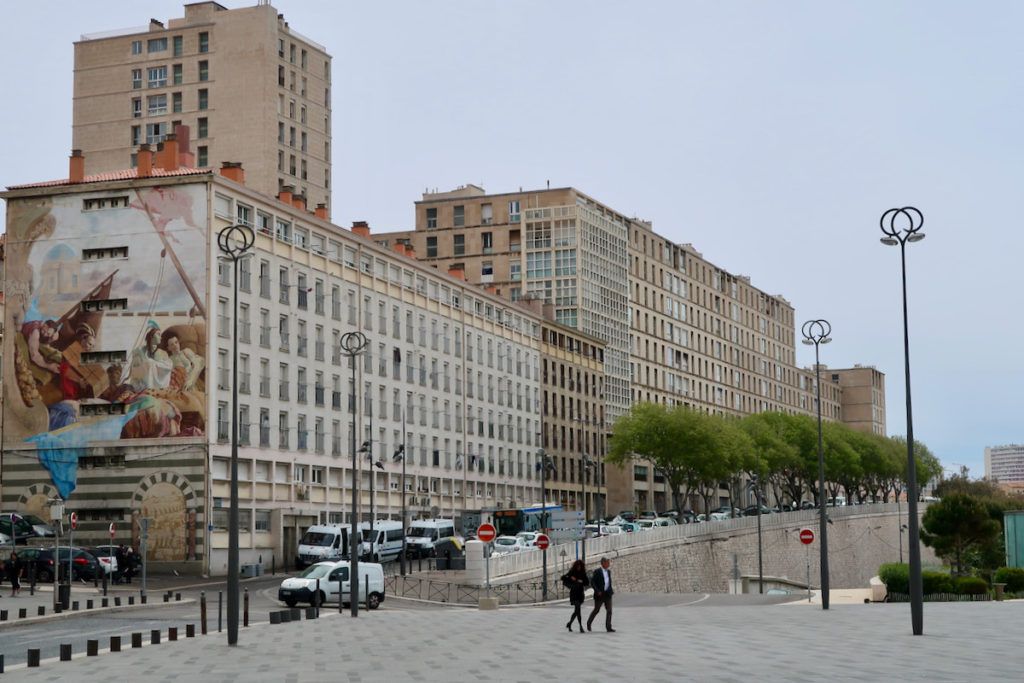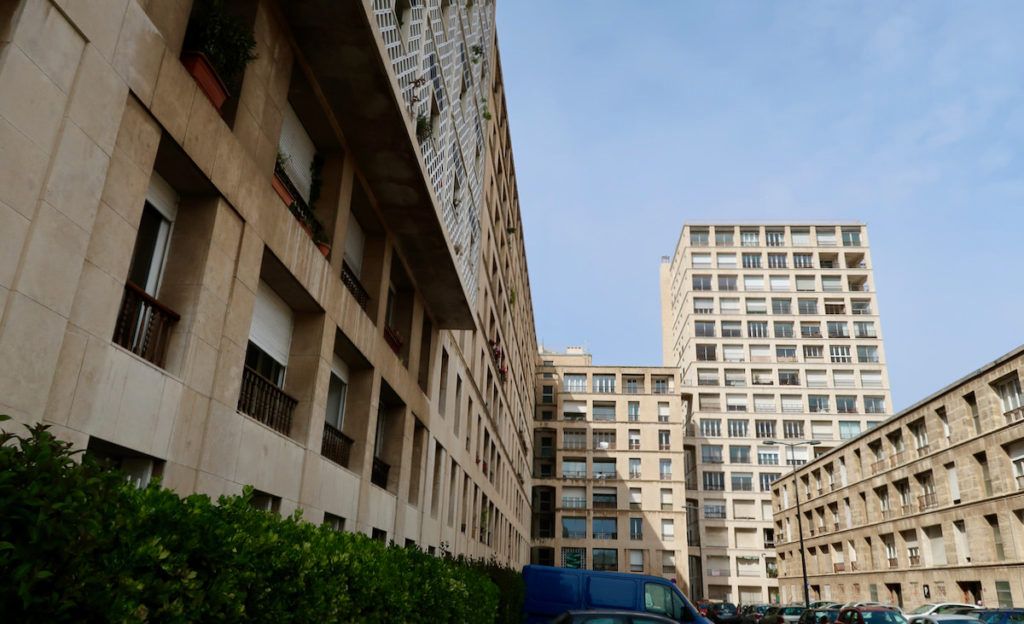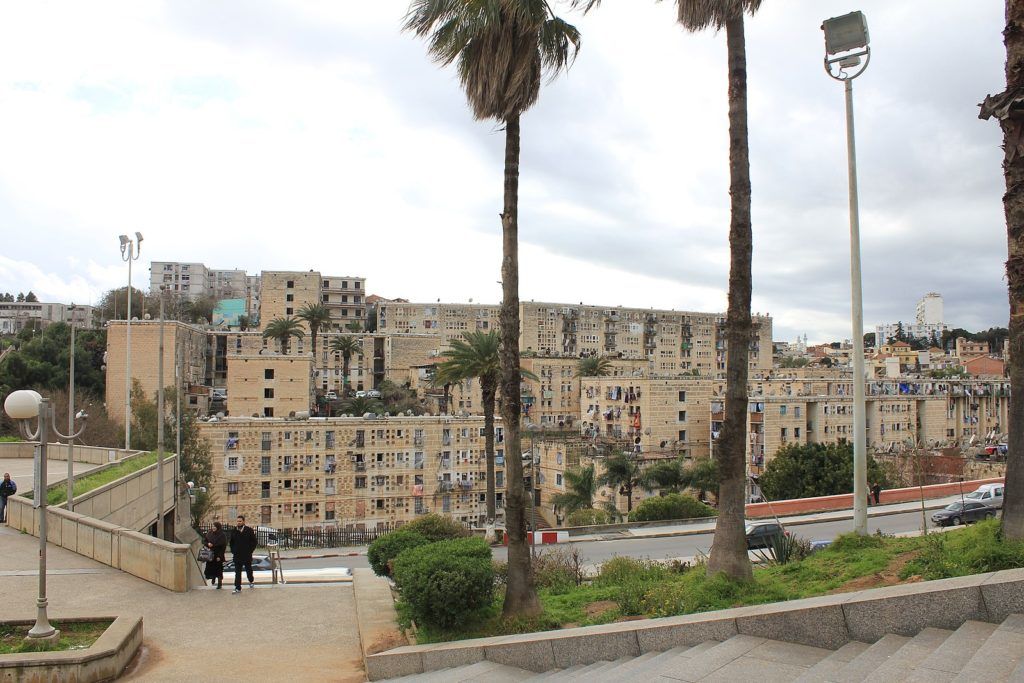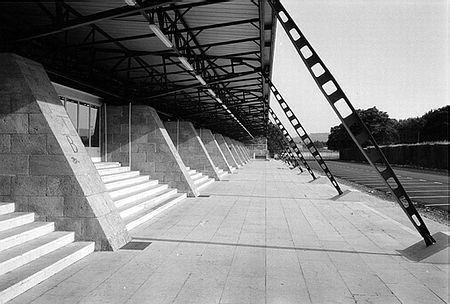Fernand Pouillon: The Future That Didn’t Happen
A short overview of the French outsider architect Fernand Pouillon. He represents a modernism which was an evolution rather than a break with tradition. In short a future that didn’t happen.

La Tourette from the Sea
Introduction
I loved the book The Stones of Fernand Pouillon but as I mentioned it’s very partial. There is so much to Pouillons career that the book omits. This is by design and that’s fine but there is much more to see. So referring to the Marseille projects I visited in 2019 and gathering some other information I have tried to bring together what I know about Pouillon to bring out a fuller more complicated picture of the man and his work. Hopefully along with the links at the end of this article it can help to provide a starting point for anyone interested in Fernand Pouillon.
I present this as an example of a mostly sidelined architects who is worthy of appraisal and reappraisal. Newly discpovered voices from which we can learn and maybe look with fresh eyes again at familiar things. Also Pouillon life and full architectural body of work is messy, big, contradictory and really interesting. Why limit yourself to a restraint that never really was there anyway right?
A Short Biography
 Fernand Pouillon
Fernand Pouillon
Born in 1912 his family was in architecture and construction already. His dad was a public works engineer and his cousin Louis Pouillon an architect in Marseille. But at first he wanted to become a painter and he left school at the age of 14 to study at the l’Ecole des Beaux-arts in Marseille. But he must have had a change of heart because he then went to Paris to study architecture from 1932. He stayed in Paris until 1946 joining the Communist Party in hiding and also designed and had built his first building at the age of twenty-two in 1934 in Aix-en-Provence before he had his Architects degree.
After his studies Pouillon joined the office of Auguste Perret like a young Le Corb decades before. Perret’s influence on Pouillon is clear with mixed classical and traditional motifs and modern building methods and types speaking of a continuity rather than a radical break which mainstream modernism was by now championing. Pouillon was involved with Perret’s reconstruction of the city of Le Havre now a UNESCO site.
With his home city of Marseille being also devastated Pouillon became actively involved in its post-war reconstruction. It is in Marseille that Pouillon first became famous with his two key projects contributing to the rebuilding of Marseille La Tourette and Vieux Port. Pouillon and his partners under the guidance of Perret were tasked with the job of rebuilding the bombed out harbour area, the old center of the city.
Based on his success in Marseille he is invited to work on big housing projects in Algiers by the major. He went on to build a huge amount of projects there also after Algeria becomes independent.
By the mid 50’s Pouillon was also building in Paris, he sets up his a parent company through which he can design and be main contractor CNL (Comptoir national du Logement). With control of the complete production chain he can fully realise the Pouillon construction system and deliver large high quality low price projects on time and on budget.
Pouillon is now famous in France and living a celebrity lifestyle with many houses and cars. He is building projects and living in the South of France, Paris and Algiers. The amount of work he is overseeing is astonishing. He probably overreaches himself and his company starts to unwind.
On 5th March 1961 Fernand Pouillon and four others are arrested and accused of false accounting, embezzlement and abuse of social property. In France from1940 the Architect of a project could no longer finance and participate in its construction, and Pouillon had broken this law.
After over a year in prison he sensationally escapes in 1962 with the help of his brother and various sympathisers. He returned voluntarily to prison however to face trial and attempt to clear his name. He failed and in 1963 was sentenced to four years in jail but released after roughly a year due to ill health.
While in Prison he wrote his work of fiction Les Pierres Sauvages(1964) for which he received the prise Prix des Deux Magots. There is at least one English edition under the name Stones of Le Thoronet. Now a free man again but unable to work in France he went to Algeria to work from 1966 to 1971 when he was pardoned by French President George Pompidou.
He returned from exile and retired to the run down Château de Belcastel in the Auvergne and started work on restoring the castle and village. He was awarded the Legion of Honour in 1985 and in 1986 at Belcastel he died at the age of 74.
Key Early Marseille Projects La Tourette & Vieux Port Marseille

La Tourette Marseille
These two early projects set the pattern in many ways for Pouillons career. La Tourette is a complex in part of the Panier district of Marseille that the Nazis destroyed trying to root out the French Resistance, and Vieux Port directly underneath this was part on the North side of the old port and are both part of the Masterplan to rebuild the city after WWII. Along with René Egger under the direction of Perret Pouillon won the project from under the nose of André Leconte who had masterplanned the rebuilding.

Marseille Masterplan La Tourette and Vieux Port
With a kind of classically inspired modernism from Perret but with local vernacular and modern abstracted touches La Tourette and Vieux Port are worth careful attention. For example in La Tourette there are bays of cantilevered balconies enclosed in cross grill lattices of wood like a modernised version of a Mashrabiya which shows the influence of North Africa and of Meditteranean typologies even before Pouillon goes to Algiers.
The project opens up on the city side to the pedestrian with partially enclosed courtyards but to the sea they are much more stark and monumental echoing the old port fortifications below. This is an inspired modern housing development full of varied references to the past tied into the city and also making use of modern construction methods and modernist abstracted architectural elements.

La Tourette Inside Courtyard
Here he claimed to be able to build 200 dwellings in 200 days within a budget of 200 million francs. This was about 25% less and a lot faster than his competitors. - ref Video 45 seconds in. Doing this cemented his reputation and he was soon invited to Algiers to repeat the feat of quick, economical high quality building.
Pouillon’s method of designing and building refined here came to be known as The Pouillon System. It was a way of co-ordinting all the elements of a project. It is not clear to me how it worked exactly but looked like the projects were laid out and drawn up on a grid system to help to coordinate the different processes. He used a combination of construction techniques to save time, and mixed standardisation with input from the craftsmen to further reduce cost of labour but also to achieve a less industrial look.

Vieux Port
The Pouillon Construction System
His methodology is that he didn’t sketch much but went straight to techincal or working drawing, the plans being drawn up to the grid and system Pouillon set down and altered from there. - ref
Some interesting construction techniques were used for example;
Pierre banché
- A construction System using slabs of stone as permanent shuttering to save time and money and to cast real stone cladding for the project. Achieving a traditional stone construction with a modern technique.
’Marmites’ concrete floor

- A reinforced concrete cross ribbed floor system for strength and lightness. It used ‘Marmites’ or terracotta bricks infilled with concrete. It was a grid system of 60cms and this in turn gave the module for the rooms, windows and elevations a way to standardise the elements together.
His building system was not a modernisation for its own sake, rather it was a modification or interpretation of how to build through Pouillons own sensibilities.
Sensing presciently that the architect’s power was slipping away, his fondness for medieval craft led him to try and recover the synthetic, total mastery of the building process that he saw in the ancient architects: ‘that thought simultaneously as an organizer, a financer, an engineer, an inventor and an artist.’ Pouillon’s interpretation was to integrate the engineering consultants into his own office, to forge intimate links with suppliers, to buy materials directly and to take on more and more of the project management, to become
a contractor and even an investor. For Pouillon this engagement with all aspects of the building process was not only necessary to control the building methods and process, but also to face the many challenges that modernity was offering. The architect facing modernity was given an extended role and only through this expanded professional role could the conventions of building be qualitatively redefined. - Reconstructing Convention
Algeria
Following the success of his Marseille redevelopment Pouillon was commissioned in 1953 by the city of Algiers by the mayor Jacques Chevallier to repeat a similar project for them. Within a year he created in 1600 residential units in Algier.

Diar-el-Mahçoul source Wikimedia
The Diar-es-Saada and Diar-el-Mahçoul housing developments, 800 and 1,800 units respectively finished in 365 days with thoughtful respect to the local vernacular and local urban design.
The 1954 development of Diar el Mahçoul for example was probably the first intentionally racially mixed housing development by the French in Algiers. The housing quarters are segregated but the communal spaces are not. The development is according to Pouillons construction system also. The precept blocks of Limestone for the walls shipped from Arles in France.
Back in Algeria during his exile from France he built for the newly independent Algeria. He designed a whole host of houses, hotels, towns.
Other Work
While he is best known for his housing his other projects show Pouillon versatility and his stylistic flexibility.
The Aix-en-Provence City Stadium (1947) , Nestlé Factory (1948) in Saint-Menet, Station sanitaire maritime, Marseille showcase a talent that is not just concerned with housing. They all appear more modern, while not fully dropping the systematic rhythmic impressions of his housing projects.

Aix-en-Provence City Stadium
He also worked in Iran with Machad and Tabriz railway station, Tehran National Geography Insitute to name just a few. The projects I have mentioned above are really just a drop in the bucket Pouillon really was amazingly prolific.
Criticism
So we can draw a line through Perret and Pouillon and we can see that Pouillon while working as a modern architect differed from modernists around him in some key philosophies. He advocated for the closed order rather than the open order and as such was much more an Architect and urbanist and advocate for the city.
See how his Marseille buildings fundamentally differ from Unite d’habitation in this regard. Corbusiers building also in Marseille is completely different philosophically from Pouillons Vieux Port.
Unite d’habitation is a kind of white elephant- It’s placed well outside the center, it’s anti-urban. It sits above the landscape it is not aligned to the street patterns on purpose. This is a vision of the future with no city at all, just park, roads, and buildings all basically separate. The idea of the European city literally exploded. Corbusier was able to negotiate exemption from any building regulations of the time allowing him to build to his modular system. The building was extremely experimental, with many integrated services that never really worked. For example it had a level of shops an idea which never worked until it became a tourist destination.
The Vieux Port projects by contrast are city building, structured and proportioned to the city surrounding it and to the city that was destroyed. They facilitate the exiting city rather than stand apart. They are banal on the grand scale and responsive at the scale of the pedestrian or the residents. They were built according to the requirements of the public system, fast and on budget. They integrate into the existing urban fabric, indeed rescuing them from the War. They are modern but incorporate the vernacular do not alienate the rest of the existing city.
He favoured the vertical window rather than the horizontal one the proportional of a building set into the urban sphere rather than apart. He also loved traditional materials and a sense of order and symmetry more in tune with the rhythms of a the Beuxs Arts architects of the generations before.

La Tourette looking into the courtyard
Conclusion
Pouillon industrialised the construction processes by considering the building as an architectural object more as an industrial product. Instead of wiping the slate clean and starting again he took the best of traditional 17th and 18th century city architecture while updating it with technology of the time allowing him to build as efficiently as possible rather than to experiment with new forms and materials per se. By developing a more integrated design and building solution he was able to build efficiently and to a high level of quality which makes him stand out.
Pouillon is referred to in The Stones of Fernand Pouillon and amongst other critics as a classical modernist synthesising forms into a modern context. Thus he is often seen as presenting a different kind of modernism that didn’t break with the past so much as synthesise it, an alternative architectural future that didn’t happen.
While I would agree, I think the story is more messy than that. Pouillon was very interested in the vernacular, in the genius loci of a place and how to represent it. Even before going to Algiers in Marseille he was incorporating versions of North African vernacular into his housing projects. He designed a host of other public buildings I haven’t touched on here at all and I have no doubt they reveal a richer palette still.
Maybe the overall point is that Pouillon was very interested in synthesising history, place and identity into his buildings in new ways. He is less a continuation of traditional views than many see and less ‘authentic’ also but much more experimental, a little more ambiguous. He was a builder, he knew what it was to make a place to live or work and to imbue it with a unique identity which none the less spoke to the roots of the place and its people.
There is also something about the man I like. He went from playboy to monk in his lifetime, married four times and converted to the Muslim faith. About to marry an Iranian Princess, he pulled out at the last minute to look after his daughter. His life speaks of a daring life-embracing philosophy who’s buildings are generous for everyone. Life like design is a journey to be embraced so the last word should go to Pouillon himself. In his diary he tells us of the moment of his escape from prison about to embrace the life of a renegade….
On September 8, 1962, at 8:30am., I was standing on the eaves of the mansard between the bedroom window and the bathroom. I had tied a double rope to the radiator near the sink. I had woven it myself, and then smeared it to make its color match that of the roof tiles, but the rope proved not to be long enough, because of the knots that had reduced its length. We often think of all the details, and then, at the last moment we discover some basic oversights….The intertwined strips stretched between the radiator and the balcony allowed me to drop the main part of the rope straight down onto the drainpipe. A man was whistling to himself down below in the garden. I was calm. I was weighing less than fifty kilograms at the time, clothes included. The manouver would have been acrobatic. “I am occupying a high position, “ I though, and a smile came spontaneously to my lips… - F Pouillon, mémoires Via Architecture and Violence
Further Reading
- architecture misfit fernand pouillon. Should be everyones first stop for an overview of Pouillon and why he is interesting.
- Fernand Pouillon - Wikipedia - Good overview of his career and work.
- www.archipicture.eu - Fernand Pouillon
- Château de Belcastel
- Re-discovering Fernand Pouillon - Domus Pouillon in Algiers
- Step Back In Time: An Algerian Architecture Adventure - Architectural Digest Middle East
- Archiwebture - Objet PERAU-280. Vieux Port, Marseille (Bouches-du-Rhône) : reconstruction. 1951-1954 - Galerie d’images - an archive which contains a small number of drawings and fotos of Pouillons work in Marseille.
Short Mixed Bibliography
- The Stones of Fernand Pouillon by Adam Caruso and Helen Thomas
- Architecture and Violence Pouillons time as a man on the run from justice is covered here.
- Modern Architecture and The Mediterranean -Some good insight into his projects and the fact he is pulling details from North Africa prior to his work there.